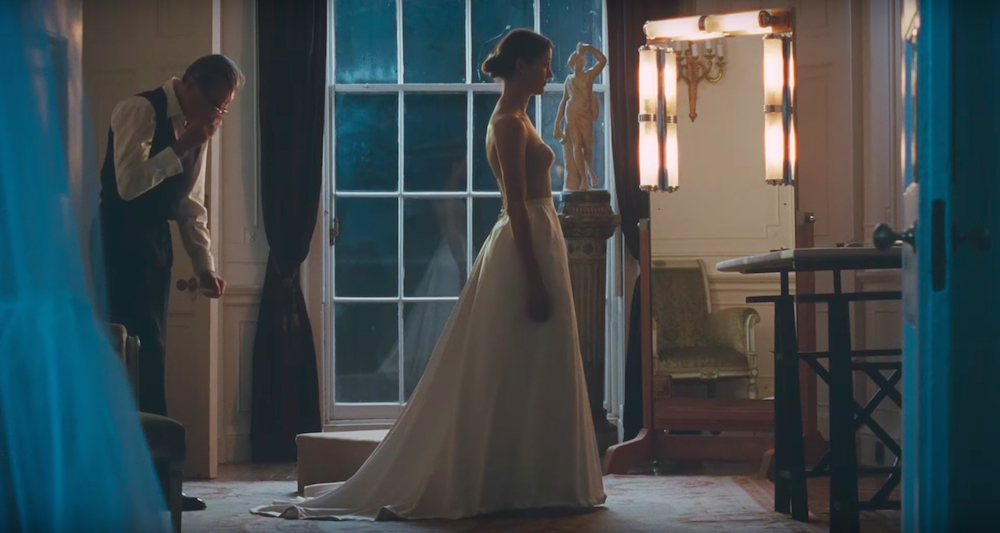Jonny Greenwood is operating on a different plane from the rest of us. In an interview with the BBC, Greenwood’s longtime collaborator Paul Thomas Anderson confessed that it takes him “a little while to catch up” with Greenwood’s compositional ideas, even after he’s written scores specifically for Anderson’s films. Greenwood, who is also the lead guitarist for Radiohead, has scored much of Anderson’s work since their first collaboration on 2007’s There Will Be Blood, and it’s this ostensible disconnect — that sense of taking a little while to catch up — that has fueled the artistic partnership between filmmaker and composer.
You can feel Greenwood pushing against Anderson’s shots, distorting them with sound even as he complements them. Without the throbbing, percussive anxiety of Greenwood’s score for The Master, or the warm, sun-soaked haze of tracks like “Amethyst” on the score for Inherent Vice, Anderson’s films lose a degree of subtlety in their dense concentration of meaning. The relationship between Greenwood and Anderson is crucial to the role of music in these films. Like the films and their scores, Greenwood and Anderson are partners in their being ever-so-slightly out of joint.
Phantom Thread, released at the tail end of last year, marks the first Paul Thomas Anderson film in which diegetic sound is as essential as Greenwood’s score. The film is essentially a period piece, charting the sensual drama between dressmaker Reynolds Woodcock (Daniel Day-Lewis) and waitress Alma (Vicky Krieps) in 1950s London. Sonic and visual aesthetics are at the fore, and are informed mostly by the film’s deep connection to place; Woodcock’s dresses, as well as the film’s art and sound direction, are inextricably tied to London.
And the mood of each shot is as much is defined by tiny moments of sonic interruption as the glistening baroque and felt-muted piano of Greenwood’s original compositions. In the sound of butter harshly spread, or of an accidental collision with a table and the clattering of silverware, Anderson has devised a film with particular emphasis on detailing the soundscape of the everyday. Every cup of tea raised and every scone bitten is considered and purposeful. The fastidious Reynolds Woodcock, famously committed to ritual, is deeply attuned to these sounds. When they are disturbed or out of order (as when Alma applies too much pressure to the knife buttering her toast), Woodcock doesn’t hesitate to express his annoyance. Consequentially, the patterns of sound that permeate the House of Woodcock are meticulous enough that the viewer’s perception is actually heightened throughout the film. Or, at least, Anderson’s sound mixer has achieved a fantastic illusion of heighted sense perception. As we grow accustomed to the particulars of this soundscape over time, a poorly timed sip of tea or a particularly loud bite of scone feels as grating to our ears as to Reynolds Woodcock’s.
The intensification of sonic detail in Phantom Thread only amplifies the effects of Jonny Greenwood’s ecstatic baroque, and the pervasive decadence that characterizes the film’s original compositions. On first listen, the soundtrack is conventional orchestral music. Greenwood worked with a 60-piece orchestra to fill these tracks with a sense of expansiveness only hinted at in previous scores. Greenwood’s sheet music tweets point to explicitly baroque instrumentation (in the viola d’amore) and explicitly baroque dynamics, underscoring the extent to which the sounds of this film are split between the historically grounded and the avant-garde, owing as much to Bach as to Glenn Gould’s contemporary renditions of Bach. This is a period piece, after all, and the score’s veneer of traditionalism seems to match Anderson’s visual tone.
But Greenwood’s approach to baroque inverts the traditionally regimented time signatures and technically demanding passages that characterize the genre. He builds on a baroque tradition by incorporating some of the compositional malleability and softness he began cultivating on Radiohead’s 2016 album, A Moon Shaped Pool. Tracks like “Daydreaming,” and especially “Glass Eyes,” prefigure the watery sustain of Phantom Thread’s “House of Woodcock,” and “I’ll Follow Tomorrow.” The frantic strings of A Moon Shaped Pool’s opening track, “Burn the Witch,” have counterparts in “The Hem,” which taps into that same ethos for a terrifically suspenseful crescendo.
With its debt to traditional baroque music and contemporary indie rock, Greenwood’s “baroque” is more reverent pastiche than dutiful replication. It doesn’t simply emulate baroque. Rather, it innovates on it. The result is a score that defies expectation at every turn. For every traditionally orchestrated track, there’s a track that’s discordant and chopped-up. There are hints of jazz and contemporary classical composition, too, in the unconventional time signatures and abstract passages that Greenwood scatters throughout the score’s 18 tracks.
And each track, as it colors the rich visual landscape of the film, reflects that disjointedness in the artistic partnership between Greenwood and Anderson. As we watch Reynolds Woodcock, the exacting, ritualistic, slightly unhinged dressmaker at work, Greenwood’s new baroque informs how we process Woodcock’s relationship with each client flattered, each tantrum thrown. Skeletal vibrato and felt-muted sustain belie characters’ internal anguish, working symbiotically with the actors’ performances. The score adds new elements to an already complicated sensory palette; that Greenwood and Anderson are sometimes at conceptual odds only adds to that sense of peculiar angularity and flexibility that defines this new baroque.


